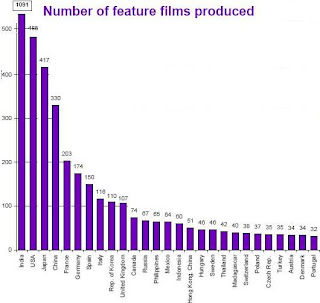An interesting survey over at UNESCO’s Institute for Statistics about the number of films made around the world (found via Nikki Finke’s Deadline Hollywood Daily).
According to the survey, India is the top filmmaking nation in the world, with 1,091 films made in 2006, followed by Hollywood with 485 “major” productions”.

(Note: Nigeria would be second, with 872 films, but those films are all shot on video and designed for home viewing, as there are virtually no cinemas in Nigeria, so Nigeria is not counted in the official survey results. Not unfair, I think… If you were to include all the independent and student and amateur films made in the United States, films of comparable or better quality than most of the Nigerian films, I’m sure the United States would be in the thousands. But, still, it is interesting to realize how much filmmaking goes on in Africa and how even there, movies are not all about Hollywood.)
Very interesting to see how big a presence Asia had in the survey — an addition to India, Japan was third, China fourth and South Korea was ninth.
Not in the survey but similarly interesting is how much money is spend on movies in those countries, too. China is on track to spend over $700 million in theaters this year, and continues to grow substantially each year. Japan is about $2 billion/year. South Korea is around $1 billion. India is impossible to guess at (I have seen estimates ranging from a few hundred million dollars to well over a billion), but it is notable.
The European box office is still larger than Asia, mostly because of higher ticket prices. But that gap is narrowing every year. And with so many films being made over here, you can see Asia rising in importance. Which is, of course, why Hollywood has been trying to find partners and possibilities in Asia over the past few years.
I do not think this is a zero-sum competition, though. Almost every country has a demand to see films about its own culture in its own language. That is not going to disappear, no matter how many “tentpole” pictures and superheroes Hollywood creates. In fact, I think we are clearly seeing the limits of the Hollywood model. Yes, US major films can be incredibly popular all over the world, but they are not the be-all-and-end-all of moviemaking. Especially now that countries like Korea and Japan have learned from Hollywood and are making entertaining films of their own.
Which is (if I may market myself a moment) one of the major points of POP GOES KOREA. Entertainment globalization is not a one-way street, even if the United States is the biggest dog on the block and has, until now, been fairly dominant. People learn and systems evolve.
We have seen it in Luc Besson and his action film company in France. We have seen it in Korea, then Japan and increasingly in China. And I think in the future, we are going to see more and more examples. Not just in movies, but in all of entertainment.


.jpg)




